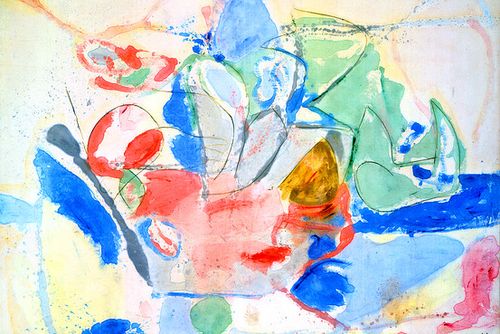
Helen Frankenthaler Mountains and Sea (1952), National Gallery of Art
In honor of Helen Frankenthaler, the great artist who died today at age 83, we offer these essays on her life's work and the painting that first made her famous, Mountains and Sea (1952).
James Panero on "Frankenthaler at 80" (2009):
Living masters have it rough, and Helen Frankenthaler has been living as a master for over half a century. In 1952, at the age of only twenty-three, she created Mountains and Sea, an iconic painting that forever secured her place in the history of art. It was a work that at once defined Frankenthaler’s style and changed the visual texture of abstract painting. Mountains and Sea built on the achievements of Jackson Pollock with its poured paint and rolled-out canvas—but it also outdid Pollock. With its thinned pigments soaked directly into linen, it displayed a new artistic temperament, subsuming the artistic ego into forms of color that absorbed the Abstract Expressionist gesture into an all-over stain.
A Recollection by the late dealer Andre Emmerich (2004):
Her work has been celebrated with more museum exhibitions than any other American artist represented by my gallery, more books and articles, and an avalanche of honorary doctorates. With it all, Helen has also managed to have more fun than most other artists do. A great party-giver, she helped me celebrate innumerable birthdays in her studio. There was always music to match, mostly Sinatra, to which she danced for hours with great style and enthusiasm.
Karen Wilkin on Frankenthaler at the Guggenheim (1998):
Mountains and Sea, with its luminous hues, diaphanous shapes, and detached fragments of line, has become a kind of icon, regarded as the Urtext of stain painting because of the way Frankenthaler disembodied color by physically merging thinned-out pigment with the very fabric of the canvas. At once landscapelike and wholly about the way paint responds to the gestures of a particular individual, at once flat and spatially suggestive, Mountains and Sea issued a challenge to the wet-into-wet, dragged paint-handling and loaded surfaces that were the hallmarks of ambitious abstraction at the start of the 1950s. Mountains and Sea was startling when it was first painted and, as anyone can attest who visited the picture in the past few years at the National Gallery, Washington (where it has been on long-term loan from the artist), it continues to look astonishingly fresh, bold, and inventive.
Karen Wilkin on Frankenthaler and her critics (1989)
I suspect that the persistence of these ideas owes more to current cynicism about how today’s art world functions than to real information. What is unquestionable is that the early Fifties were a heady time to be a young, pretty woman striving to make art in New York, especially if she had the benefit of an informed outsider, arguably the most perceptive critic of the period, as a guide. The city’s art community was a smaller, more cohesive place in those days, not yet split into Pollock vs. de Kooning vs. Rothko factions. (A position on the Stalinist purges could still make people cross the street in order to avoid one another, but that’s another matter.) Frankenthaler looked at everything—hard— and drew her own conclusions. The more aware among Frankenthaler’s commentators point out that she quickly realized, as she once put it, that “you could become a de Kooning disciple or satellite or mirror, but you could depart from Pollock.” This usually leads to the most celebrated story in the Frankenthaler corpus, the one about her making Mountains and Sea, soaking its transparent, intense colors into raw canvas, and working abstractly, although with the memory of a recent trip to Nova Scotia, as she said, “in my arms.” Aged twenty-three. It’s the picture Kenneth Noland and Morris Louis, young visitors from Washington, saw when Greenberg let them into Frankenthaler’s studio, in her absence, one weekend in 1953, the one that provoked Louis’s frequently quoted description of Frankenthaler as “the bridge between Pollock and what is possible.”